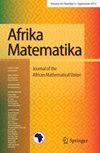求助PDF
{"title":"一些经典不等式的新改进","authors":"Abdelmajid Gourty, Mohamed Amine Ighachane, Fuad Kittaneh","doi":"10.1007/s13370-024-01218-0","DOIUrl":null,"url":null,"abstract":"<div><p>In this paper, we establish an inequality for scalars, which we then apply to refine some classical inequalities for inner product and numerical raduis. For example, we establish that for any <span>\\(\\mathcal {E}\\in \\mathcal {B}(\\mathcal {H}),\\)</span> <span>\\(u,v\\in \\mathcal {H},\\)</span> and <span>\\(0\\le \\theta \\le 1\\)</span>, </p><div><div><span>$$\\begin{aligned} |\\langle \\mathcal {E} u,v\\rangle |^2&\\le \\mathcal {U}_{(n,\\xi )}\\left( \\eta ,|\\langle \\mathcal {E}u,v\\rangle |,\\sqrt{\\left\\langle |\\mathcal {E}|^{2 \\theta } u,u\\right\\rangle \\left\\langle \\left| \\mathcal {E}^*\\right| ^{2(1-\\theta )} v, v\\right\\rangle }\\right) \\\\ &\\le \\left\\langle |\\mathcal {E}|^{2 \\theta } u,u\\right\\rangle \\left\\langle \\left| \\mathcal {E}^*\\right| ^{2(1-\\theta )} v, v\\right\\rangle . \\end{aligned}$$</span></div></div><p>Moreover, we have <span>\\(\\left( \\mathcal {U}_{(n,\\xi )}\\left( \\eta ,|\\langle \\mathcal {E}u,v\\rangle |,\\sqrt{\\left\\langle |\\mathcal {E}|^{2 \\theta } u,u\\right\\rangle \\left\\langle \\left| \\mathcal {E}^*\\right| ^{2(1-\\theta )} v, v\\right\\rangle }\\right) \\right) _{n \\geqslant 0}\\)</span> is an increasing sequence satisfying </p><div><div><span>$$\\begin{aligned} \\lim \\limits _{n \\rightarrow +\\infty } \\mathcal {U}_{(n,\\xi )}\\left( \\eta ,|\\langle \\mathcal {E}u,v\\rangle |,\\sqrt{\\left\\langle |\\mathcal {E}|^{2 \\theta } u,u\\right\\rangle \\left\\langle \\left| \\mathcal {E}^*\\right| ^{2(1-\\theta )} v, v\\right\\rangle }\\right) = \\left\\langle |\\mathcal {E}|^{2 \\theta } u,u\\right\\rangle \\left\\langle \\left| \\mathcal {E}^*\\right| ^{2(1-\\theta )} v, v\\right\\rangle , \\end{aligned}$$</span></div></div><p>which presents a novel refinement of the well-known mixed Schwartz inequality. Our results extend and refine well-established inequalities found in the literature.</p></div>","PeriodicalId":46107,"journal":{"name":"Afrika Matematika","volume":"35 4","pages":""},"PeriodicalIF":0.9000,"publicationDate":"2024-11-26","publicationTypes":"Journal Article","fieldsOfStudy":null,"isOpenAccess":false,"openAccessPdf":"","citationCount":"0","resultStr":"{\"title\":\"New improvements of some classical inequalities\",\"authors\":\"Abdelmajid Gourty, Mohamed Amine Ighachane, Fuad Kittaneh\",\"doi\":\"10.1007/s13370-024-01218-0\",\"DOIUrl\":null,\"url\":null,\"abstract\":\"<div><p>In this paper, we establish an inequality for scalars, which we then apply to refine some classical inequalities for inner product and numerical raduis. For example, we establish that for any <span>\\\\(\\\\mathcal {E}\\\\in \\\\mathcal {B}(\\\\mathcal {H}),\\\\)</span> <span>\\\\(u,v\\\\in \\\\mathcal {H},\\\\)</span> and <span>\\\\(0\\\\le \\\\theta \\\\le 1\\\\)</span>, </p><div><div><span>$$\\\\begin{aligned} |\\\\langle \\\\mathcal {E} u,v\\\\rangle |^2&\\\\le \\\\mathcal {U}_{(n,\\\\xi )}\\\\left( \\\\eta ,|\\\\langle \\\\mathcal {E}u,v\\\\rangle |,\\\\sqrt{\\\\left\\\\langle |\\\\mathcal {E}|^{2 \\\\theta } u,u\\\\right\\\\rangle \\\\left\\\\langle \\\\left| \\\\mathcal {E}^*\\\\right| ^{2(1-\\\\theta )} v, v\\\\right\\\\rangle }\\\\right) \\\\\\\\ &\\\\le \\\\left\\\\langle |\\\\mathcal {E}|^{2 \\\\theta } u,u\\\\right\\\\rangle \\\\left\\\\langle \\\\left| \\\\mathcal {E}^*\\\\right| ^{2(1-\\\\theta )} v, v\\\\right\\\\rangle . \\\\end{aligned}$$</span></div></div><p>Moreover, we have <span>\\\\(\\\\left( \\\\mathcal {U}_{(n,\\\\xi )}\\\\left( \\\\eta ,|\\\\langle \\\\mathcal {E}u,v\\\\rangle |,\\\\sqrt{\\\\left\\\\langle |\\\\mathcal {E}|^{2 \\\\theta } u,u\\\\right\\\\rangle \\\\left\\\\langle \\\\left| \\\\mathcal {E}^*\\\\right| ^{2(1-\\\\theta )} v, v\\\\right\\\\rangle }\\\\right) \\\\right) _{n \\\\geqslant 0}\\\\)</span> is an increasing sequence satisfying </p><div><div><span>$$\\\\begin{aligned} \\\\lim \\\\limits _{n \\\\rightarrow +\\\\infty } \\\\mathcal {U}_{(n,\\\\xi )}\\\\left( \\\\eta ,|\\\\langle \\\\mathcal {E}u,v\\\\rangle |,\\\\sqrt{\\\\left\\\\langle |\\\\mathcal {E}|^{2 \\\\theta } u,u\\\\right\\\\rangle \\\\left\\\\langle \\\\left| \\\\mathcal {E}^*\\\\right| ^{2(1-\\\\theta )} v, v\\\\right\\\\rangle }\\\\right) = \\\\left\\\\langle |\\\\mathcal {E}|^{2 \\\\theta } u,u\\\\right\\\\rangle \\\\left\\\\langle \\\\left| \\\\mathcal {E}^*\\\\right| ^{2(1-\\\\theta )} v, v\\\\right\\\\rangle , \\\\end{aligned}$$</span></div></div><p>which presents a novel refinement of the well-known mixed Schwartz inequality. Our results extend and refine well-established inequalities found in the literature.</p></div>\",\"PeriodicalId\":46107,\"journal\":{\"name\":\"Afrika Matematika\",\"volume\":\"35 4\",\"pages\":\"\"},\"PeriodicalIF\":0.9000,\"publicationDate\":\"2024-11-26\",\"publicationTypes\":\"Journal Article\",\"fieldsOfStudy\":null,\"isOpenAccess\":false,\"openAccessPdf\":\"\",\"citationCount\":\"0\",\"resultStr\":null,\"platform\":\"Semanticscholar\",\"paperid\":null,\"PeriodicalName\":\"Afrika Matematika\",\"FirstCategoryId\":\"1085\",\"ListUrlMain\":\"https://link.springer.com/article/10.1007/s13370-024-01218-0\",\"RegionNum\":0,\"RegionCategory\":null,\"ArticlePicture\":[],\"TitleCN\":null,\"AbstractTextCN\":null,\"PMCID\":null,\"EPubDate\":\"\",\"PubModel\":\"\",\"JCR\":\"Q2\",\"JCRName\":\"MATHEMATICS\",\"Score\":null,\"Total\":0}","platform":"Semanticscholar","paperid":null,"PeriodicalName":"Afrika Matematika","FirstCategoryId":"1085","ListUrlMain":"https://link.springer.com/article/10.1007/s13370-024-01218-0","RegionNum":0,"RegionCategory":null,"ArticlePicture":[],"TitleCN":null,"AbstractTextCN":null,"PMCID":null,"EPubDate":"","PubModel":"","JCR":"Q2","JCRName":"MATHEMATICS","Score":null,"Total":0}
引用次数: 0
引用
批量引用
摘要
在本文中,我们建立了一个标量不等式,然后应用它来完善一些经典的内积不等式和数值弧度不等式。例如,我们建立了对于任何 \(\mathcal {E}\in \mathcal {B}(\mathcal {H}),\)\(u,v\in \mathcal {H},\) and\(0\le \theta \le 1\), $$\begin{aligned}|/langle \mathcal {E} u,v\rangle |^2&;\le \mathcal {U}_{(n,\xi )}\left( \eta ,|\langle\mathcal{E}u,v\rangle|,\sqrt{left\langle|\mathcal{E}|^{2\theta}u、u\right\rangle \left\langle \left| \mathcal {E}^*\right| ^{2(1-\theta )} v, v\right\rangle }\right) \ &;\u, u\rightrangle \left\langle \left| \mathcal {E}^*\right| ^{2(1-\theta )} v, v\rightrangle .\end{aligned}$Moreover, we have \(\left( \mathcal {U}_{(n,\xi )}\left( \eta ,|\langle \mathcal {E}u,v\rangle |,\sqrt{left/left/langle||^{2(1-theta )} u、u\right\rangle\left\langle \left| \mathcal {E}^*\right| ^{2(1-\theta )} v, v\right\rangle }\right) _{n \geqslant 0}\) 是一个递增序列,满足 $$\begin{aligned}\lim _{n (rightarrow +\infty }\mathcal {U}_{(n,\xi )}\left( \eta ,|\langle\mathcal{E}u,v\rangle|,\sqrt{\left\langle||^{2(1-\theta )} u,u\right\rangle \left\langle \left| \mathcal {E}^*\right| ^{2(1-\theta)}v、v\right\rangle }\right) = \left\langle |\mathcal {E}|^{2 \theta } u,u\right\rangle \left\langle \left| \mathcal {E}^*\right| ^{2(1-\theta )} v, v\right\rangle , \end{aligned}$$这是对著名的混合施瓦茨不等式的新改进。我们的结果扩展并完善了文献中的既定不等式。
本文章由计算机程序翻译,如有差异,请以英文原文为准。

 求助内容:
求助内容: 应助结果提醒方式:
应助结果提醒方式:


